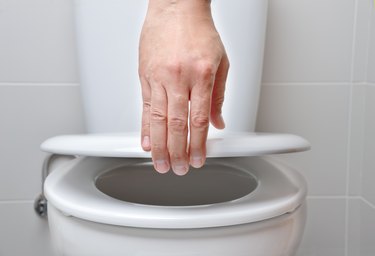
Are you stuck trying to figure out how to get rid of toilet odor? Toilets smell when you're using them, and the smell usually dissipates quickly. If you notice smells coming from your toilet even when it isn't being used, though, that's not normal. It could mean other things are going on, including a leak, blockage in the plumbing pipes or the need for a deep cleaning.
Deep-Clean the Toilet
Video of the Day
When figuring out how to get rid of toilet odor, don't overlook the need for a good cleaning. Toilets in out-of-the way places, such as basements, often escape the scrutiny those in main bathrooms receive. If yours is past due for maintenance, you may find the job more difficult than if you maintained it regularly. Mineral deposits that turn the inside of the bowl yellow can act as a catchall, and the toilet won't be truly clean until you remove these deposits.
Video of the Day
Step 1: Clean the Bowl
Mix a paste of white vinegar and borax, and spread it liberally on the inside of the bowl, especially under the rim. Leave the paste on the bowl for several hours. Moisten it by spraying it with vinegar as it dries out.
Step 2: Rinse and Scrub the Bowl
Rinse the bowl with clear water and scrub with a toilet brush. The paste should remove most of the discoloration, but if a significant amount remains, apply more paste and wait a few hours more.
Step 3: Use a Commercial Toilet Cleaner
Scrub the inside and outside of the bowl with a commercial toilet cleaner, preferably one that contains bleach.
Note: Baking soda is also a great deodorizer, but don't use it to make a paste with vinegar. It's alkaline, and vinegar is acidic, so the two react to cancel out each other's cleaning power. If you want to deodorize with baking soda, mix it with water to make a paste.
Fixing a Ruptured Wax Ring
If the toilet rocks slightly or you see water on the floor around the bowl, a leaking wax ring is probably the source of the odors. It's easy to replace the wax ring, but you need to remove the toilet and inspect the flange. It could be corroded or improperly installed.
Step 1: Disconnect the Toilet Supply Hose
Turn off the water. Flush the toilet, and hold down the handle to drain the tank. Disconnect the toilet supply hose from the fill valve connector underneath the tank, using your fingers or a wrench.
Step 2: Scrape Off Old Wax
Loosen the nuts holding the bowl to the floor using a wrench, and then lift the toilet and set it aside. Scrape the old wax away from the toilet flange with a putty knife. Deposit it on old newspaper and discard it.
Step 3: Inspect and Repair the Flange
Inspect the flange. If it's corroded, that's probably why the toilet was rocking and why the wax seal ruptured, letting the sewer odor in. Repair it with a repair ring. If it's set more than 1/4 inch below the floor surface, raise it with a flange extender. You may also be able to solve the problem by installing a larger wax ring or stacking two regular ones.
Solving Venting Problems
Venting problems can cause toilet odors in various ways, so check for those issues when deciding how to get rid of toilet odors. If the toilet shares a vent with a nearby sink, and that vent gets blocked, water flowing through the pipe may force air through the toilet P-trap. On the other hand, the vacuum behind that water may pull water out of the trap and allow gases to escape. Both conditions can also result from a blockage in the main vent stack in the roof.
Step 1: Plunge the Toilet
Plunge the toilet. If there's a blockage in the vent the toilet shares with a sink, the pressure of plunging should clear it. Fill nearby sinks, bathtubs and showers with an inch of water, and plunge them also.
Step 2: Check the Roof Vent
Climb on the roof and look for debris blocking the roof vent. You may find leaves, sticks or even a bird's nest. Clear the debris, and then spray water from a garden hose into the vent. If the water backs up, clear the blockage with a sewer auger until water flows without overflowing.
Step 3: Thaw an Iced-Over Vent
Go into the attic, if the problem happens in winter, and locate the main vent stack. It should be over the main bathroom. Heat the section just below the point at which it passes through the roof, using a hair dryer. The vent is probably iced over, and the heat will melt the ice.